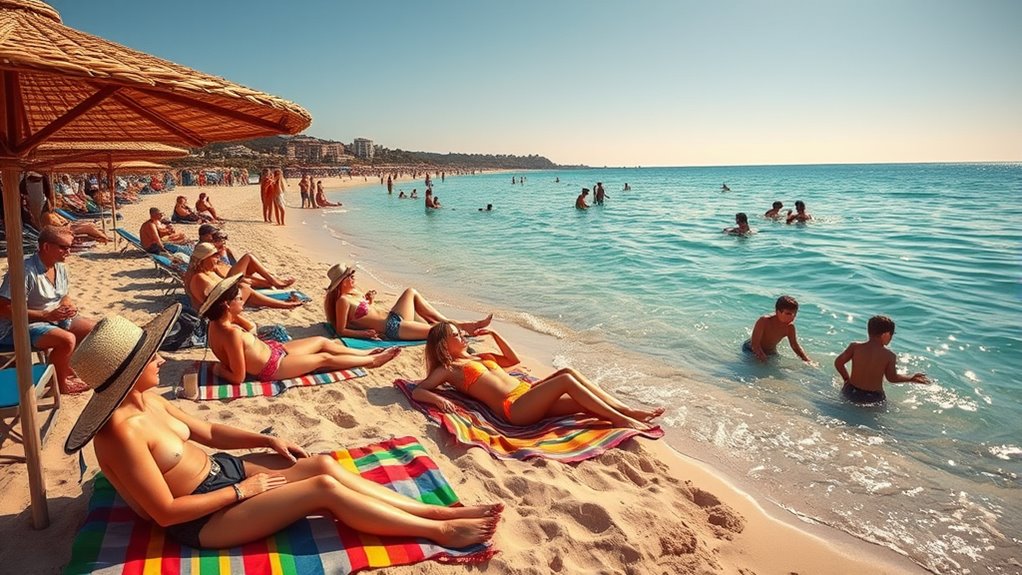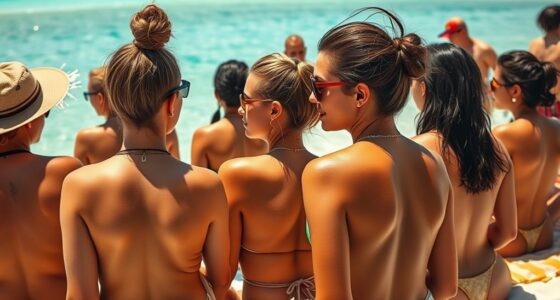Tanning is a social activity that often happens at beaches, pools, and outdoor events where people seek to enhance their appearance and gain social approval. You might notice that friends, family, and peers influence your tanning habits, as these settings promote a shared aesthetic of health, vigor, and attractiveness. Media and social media further reinforce these norms, shaping what’s considered fashionable and desirable. Keep exploring to understand how social settings and norms continue to influence tanning behaviors and perceptions.
Key Takeaways
- Beaches, pools, and outdoor festivals promote tanning as a social activity linked to fun, relaxation, and social validation.
- Group outings encourage shared tanning practices, reinforcing social norms around appearance and attractiveness.
- Visibility of tanned peers influences others to tan for social acceptance and conformity.
- Tanning together at social events fosters bonding and emphasizes beauty standards within peer groups.
- Social media amplifies these settings’ influence, showcasing tanned lifestyles as desirable and aspirational.
The Cultural Perception of Tanned Skin as Attractive
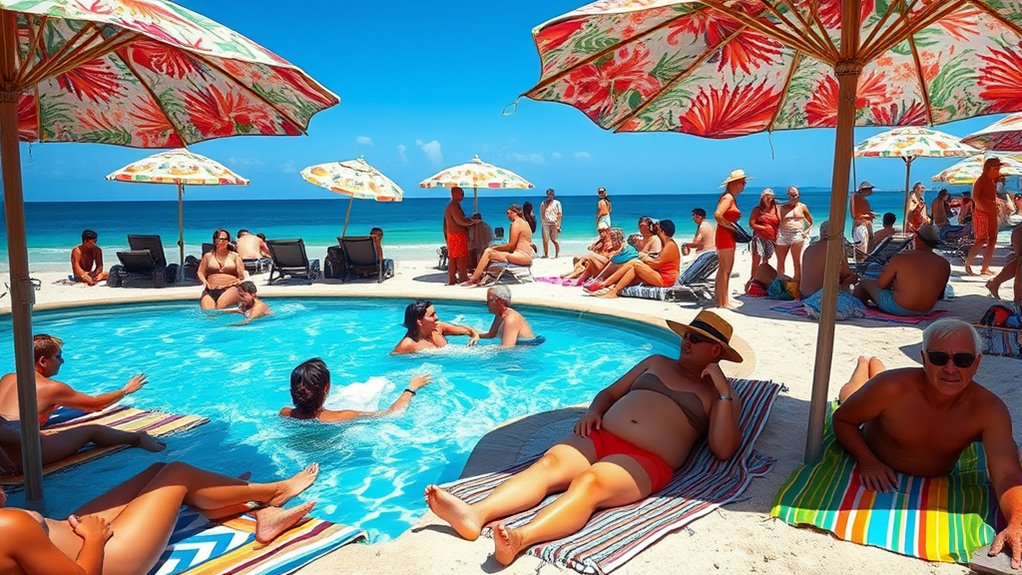
The perception of tanned skin as attractive has evolved considerably over time, shaped by cultural shifts and social attitudes. In Western history, it was once linked to outdoor labor and lower social status, making fair skin a symbol of wealth and refinement. However, in the early 20th century, tanning became fashionable among the upper classes, signifying leisure and luxury. Meanwhile, many Eastern cultures have long valued fair skin as a marker of higher social standing and beauty. Since mid-20th century, increased awareness of sun damage and skin cancer shifted some perceptions, but the desire for a “healthy glow” persists. Tanned skin now often symbolizes vitality and an active lifestyle in Western societies, reinforcing its status as an attractive feature. Additionally, understanding the energetic aspects of self-care can influence how individuals approach beauty standards and self-image. Recognizing the cultural significance of skin tone variations can foster greater appreciation for diverse beauty ideals across societies, especially as beauty standards continue to evolve globally. Moreover, the influence of media and celebrity culture plays a significant role in shaping perceptions of attractiveness and skin tone preferences, further impacting societal ideals.
Media Influence and Beauty Standards
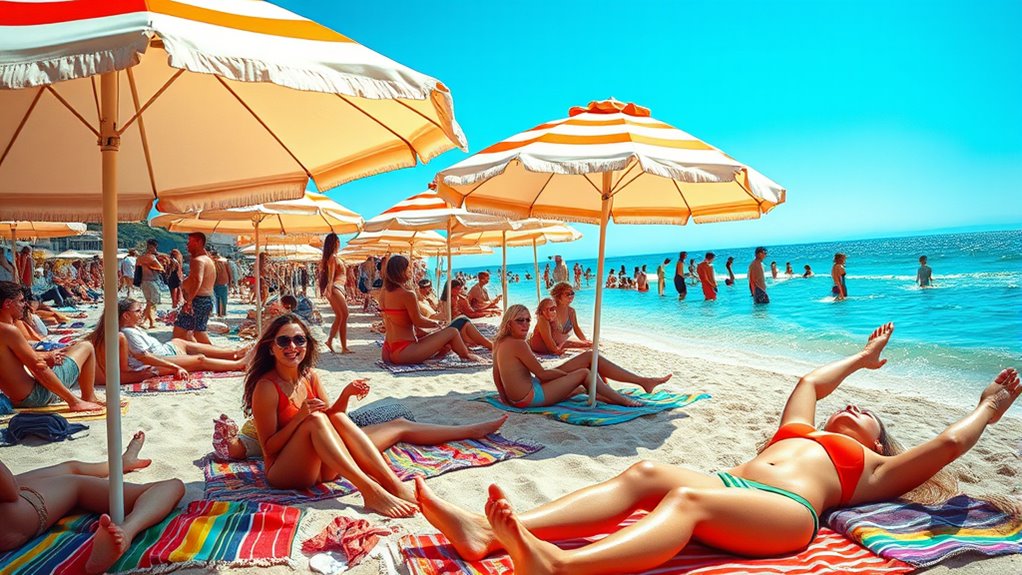
Media plays a powerful role in shaping beauty standards, especially when it comes to promoting tanned skin as desirable. You’re influenced by how celebrities and models are portrayed, often showcasing a sun-kissed glow as the ideal look. Fashion magazines like *Vogue* and *Harper’s Bazaar* have historically shifted beauty ideals toward tanned skin since the 1920s. On social media, influencers and celebrities amplify these standards, encouraging you to seek a tan. They also promote indoor tanning businesses, sometimes downplaying health risks. This media reinforcement makes tanned skin seem fashionable and normal, fueling your desire to conform. As a result, you may internalize these beauty ideals, compare yourself to others, and feel pressured to achieve the “perfect” tan to fit societal norms. Additionally, understanding the cybersecurity aspects of online content can help you critically evaluate the health claims made by tanning advertisers. Recognizing the influence of media portrayal can empower you to make healthier choices and challenge unrealistic beauty standards. Developing awareness of industry marketing tactics can help you resist misleading messages and prioritize your well-being. Moreover, the visual influence of images online can significantly impact your perceptions of beauty and desirability. Being aware of media-driven beauty standards can also help you develop a more positive body image and promote self-acceptance.
Social Settings That Promote Tanning Behaviors

Social environments like beaches, pools, and outdoor events play a significant role in encouraging tanning behaviors. At beaches and outdoor pools, the social setting fosters tanning as a way to boost appearance and gain social validation. Group outings often make tanning a shared activity, with expectations to achieve a desirable, sun-kissed look. Seasonal visits increase tanning as people conform to peer aesthetics and want to project a fun, attractive image. Indoor tanning salons also promote social interaction, with users seeking confidence and acceptance through shared experiences. Social events like parties and festivals emphasize appearance, encouraging tanning as part of the aesthetic ritual. Fitness communities further reinforce tanning, linking it to health and body image, motivating members to maintain a bronzed look as a social norm. Additionally, the use of cookies to track visitor interactions can influence targeted advertising and social perceptions related to tanning products and behaviors. The desire for a healthy glow often drives individuals to participate in these social tanning activities, reinforcing the cultural importance placed on bronzed skin. Recognizing the influence of home decor elements such as wall organization and decorative accessories can also subtly shape perceptions of personal aesthetics associated with tanning. Moreover, the use of tanning products in social settings often reinforces the desire for an even, natural-looking tan, further fueling tanning behaviors in various environments.
Peer and Family Roles in Tanning Norms

Peer and family influences play a crucial role in shaping tanning norms, often guiding your perceptions and behaviors without you realizing it. If your friends value a tan, you’re more likely to see tanning as desirable, especially if they go together for indoor sessions or pool days. Peer pressure can push teens to tan, believing it’s expected or trendy. Similarly, your family’s attitudes matter: parents who tan indoors or approve of tanning influence your choices, whether through modeling or permissions. Shared experiences like tanning together reinforce these norms. Family and friends create social learning environments, shaping what’s acceptable and attractive. These influences often work together, transmitting tanning habits across generations and impacting how you view beauty and health standards within your social circles. Additionally, understanding symptoms of breast cancer can be vital for early detection and health awareness, emphasizing the importance of health education within communities. Recognizing how peer and family roles influence health behaviors can help you make more informed decisions about your well-being. Moreover, recognizing the role of social influences can help you develop healthier habits and critical awareness of beauty standards. Building awareness of home improvement strategies, like decluttering, can also promote a healthier and more organized living environment, indirectly supporting overall well-being.
The Role of Social Media in Shaping Tanning Trends
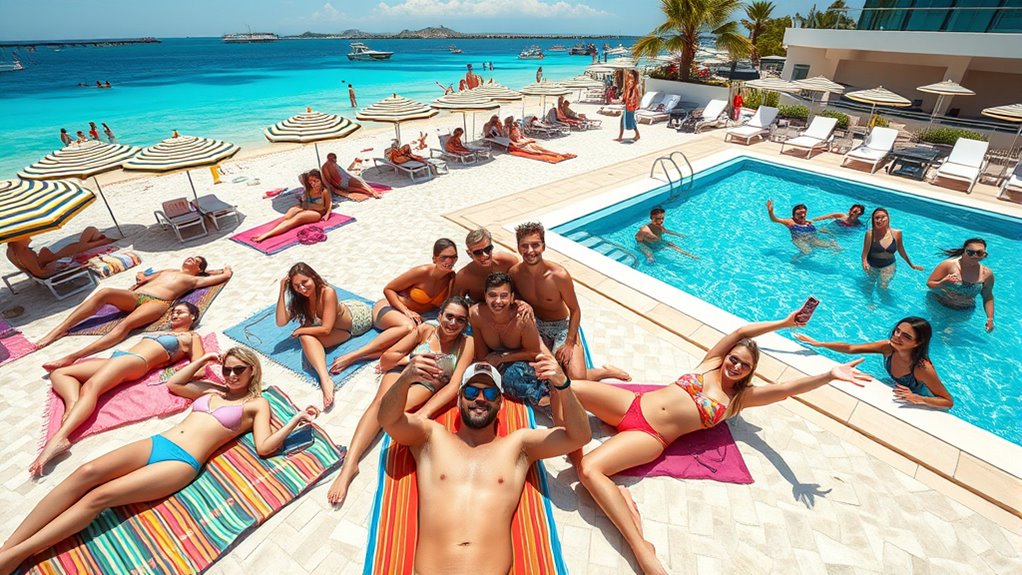
With over 90% of teens and young adults using social media daily, these platforms substantially influence tanning trends. Instagram, Twitter, and Pinterest see higher indoor tanning rates linked to regular use, especially among young adults. Tanning businesses target these platforms for advertising, often using pop culture references to attract attention. Public health campaigns leverage social media’s reach to promote sun safety, especially from February to May when tanning searches peak. Despite the risks, many posts highlight tanning’s positive aspects, with little emphasis on health dangers. Influencers and visual platforms like TikTok and Instagram shape trends through appealing images and relatable personalities. Teens trust influencers’ recommendations, often ignoring parental advice, while misleading trends and social comparison foster body dissatisfaction and risky tanning behaviors. Additionally, the influence of social media can complicate risk assessment by encouraging risky behaviors without fully understanding potential health consequences. Moreover, the use of eye patches as skincare tools is often showcased in beauty routines, further influencing cosmetic trends. Social media also promotes a rustic aesthetic that aligns well with farmhouse bedroom decor, impacting interior design preferences. Furthermore, the proliferation of personality insights from self-understanding tools can shape how young individuals perceive their image and beauty standards online. Interestingly, the promotion of healthy lifestyle choices on social media can sometimes contrast with the glamorization of tanning, creating conflicting messages for impressionable audiences.
Group Activities and Their Impact on Tanning Practices
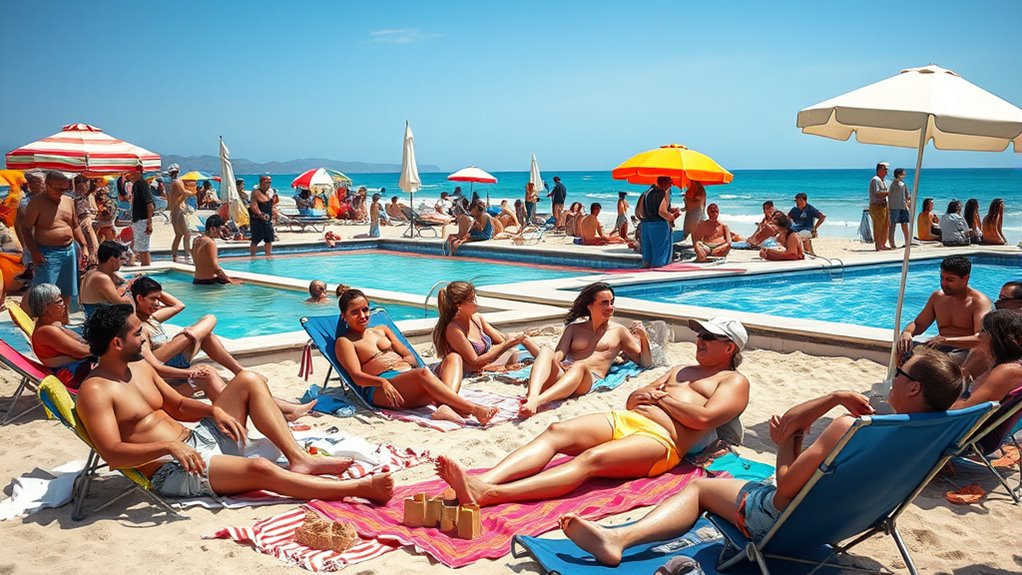
Group activities play a significant role in shaping tanning practices by creating environments where sun exposure is encouraged and socially accepted. When you attend beach or pool parties, tanning often feels like a natural part of the experience, reinforced by peer behaviors. Social gatherings like festivals and outdoor concerts increase the likelihood of spending extended time in the sun, making tanning a shared norm. Peer pressure can normalize tanning, pushing individuals to conform to group standards of beauty and attractiveness. In communities with high outdoor activity levels, residents may feel more compelled to tan to fit in. These social settings often reinforce the idea that a tan signals health and robustness, further encouraging sun exposure as part of group identity. Additionally, the pervasive visibility of vetted tanned individuals in these settings can influence others to adopt similar tanning habits to maintain social acceptance. Moreover, in many cases, the desire to enhance appearance and meet aesthetic ideals promoted within social groups further motivates individuals to seek a tanned look.
Appearance-Driven Motivations Behind Tanning
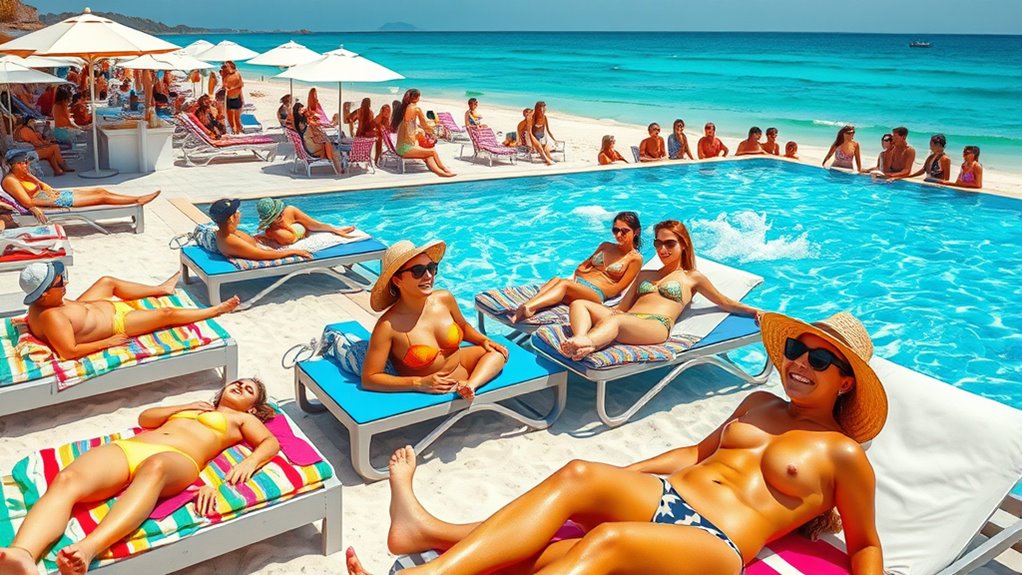
Appearance often drives people to seek out tanning, making it the primary reason for sunbathing and using tanning beds. You’re influenced by media, family, and friends who emphasize a tanned look as attractive and desirable. Many believe a darker tan boosts their overall attractiveness and enhances their physical fitness, fueling their motivation to tan. For some, the desire to look good outweighs concerns about health risks. Social motives also play a big role—being perceived as attractive and making positive impressions motivate tanning behaviors. People with obsessive traits may invest more effort into maintaining their tan, driven by appearance concerns. Often, warnings about premature aging or skin damage have less impact than the desire to look good, highlighting appearance as the main driving force behind tanning choices.
Demographic Patterns and Tanning Attitudes

Demographic factors substantially shape how people perceive and engage in tanning. Younger adults, especially those aged 18-29, are more likely to tan, with over 20% using indoor tanning beds, compared to just under 8% of seniors aged 65 and older. Attitudes toward tanning also vary by ethnicity, with some groups viewing tans as more attractive, influencing behavior. Gender differences persist, with women generally more inclined to tan than men. Education plays a role too; those with higher awareness of health risks may tan less. Socioeconomic status affects access to tanning facilities and attitudes, often leading wealthier individuals to tan more frequently. Overall, age, ethnicity, gender, education, and socioeconomic factors markedly impact how you and others view and participate in tanning.
Balancing Health Risks With Social Benefits
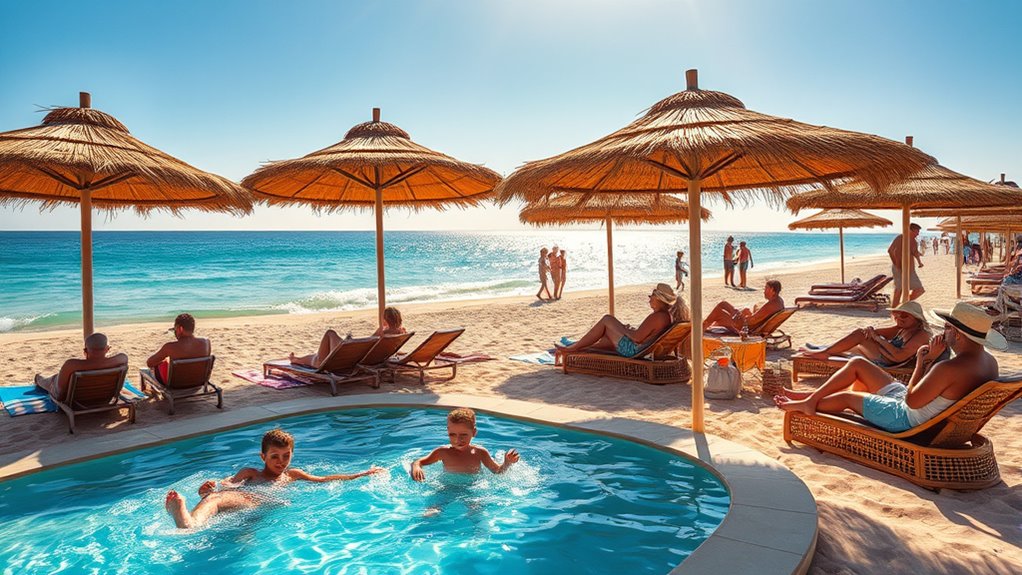
Balancing the health risks of UV exposure from tanning with its social benefits requires careful consideration. While tanning boosts confidence and social acceptance, UV radiation increases skin cancer risks, including melanoma, squamous, and basal cell carcinomas. Indoor tanning, especially before age 35, doubles melanoma risk, and higher rates are seen in young women due to frequent tanning. Despite these dangers, many associate tanning with attractiveness and social belonging, especially at beaches and pools. Education campaigns that highlight the risks and promote safe behaviors—like using sunscreen and avoiding sunburn—can help. Social media initiatives can counteract misinformation from influencers promoting tanning beds for benefits like vitamin D or SAD relief. Striking a balance involves respecting social desires while prioritizing long-term health.
How Social Norms Reinforce Tanning Habits
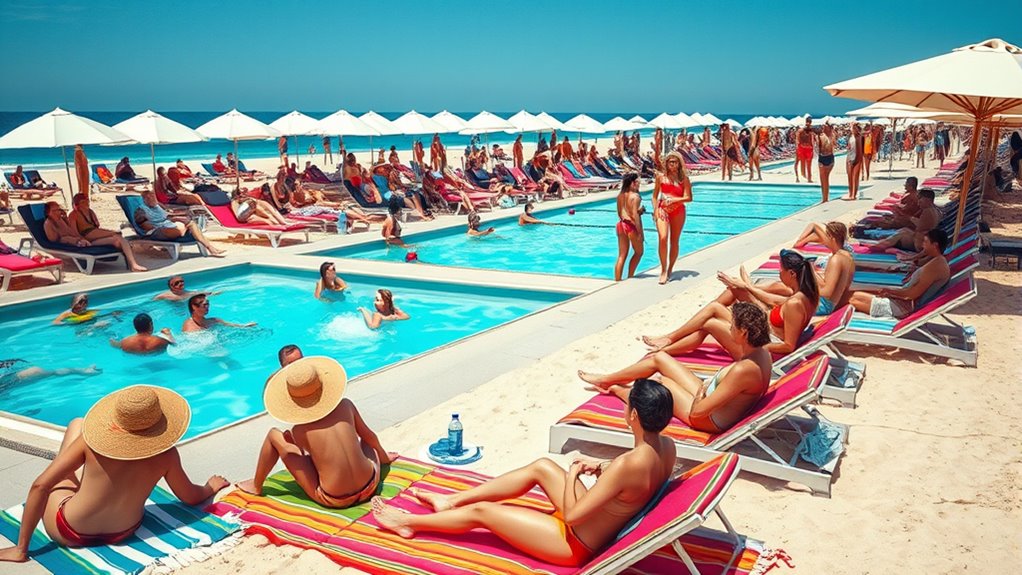
Social norms play a powerful role in shaping tanning habits by creating a perception that having a tan is both common and socially accepted among peers and media figures. When you see friends and family tanning, it reinforces the idea that it’s normal and desirable. Admiring celebrities with tans makes tanning seem glamorous and ideal, pushing you to emulate that look. Peer comments and social monitoring heighten tan surveillance, fueling dissatisfaction with natural skin tones and encouraging tanning as a way to fit in. Media representations amplify this effect by constantly showcasing tanned models as the standard of beauty, health, and status. These social cues, combined with perceived approval from others, make tanning habits more ingrained and harder to resist, especially among young adults.
Frequently Asked Questions
How Do Cultural Differences Influence Tanning Norms Globally?
You see that cultural differences shape tanning norms worldwide. In some regions, like Asia, fair skin symbolizes wealth and status, leading you to avoid tanning and protect your skin. Meanwhile, in North America and Europe, you might embrace tanning as a sign of leisure and health, often seeking out sun or tanning beds. Your cultural background influences your attitudes, behaviors, and choices about tanning, reflecting deep-seated societal values and beauty standards.
What Role Do Celebrities Play in Shaping Tanning Trends?
Celebrities play a major role in shaping tanning trends by setting beauty standards and influencing public perceptions. You see them often using spray tans or showcasing bronzed skin at events, making it desirable. Their endorsement of safe tanning methods and body image ideals encourages you to adopt similar practices. When stars embrace tanning as part of their image, it becomes a cultural norm, motivating you to pursue a tanned look to feel attractive and stylish.
Can Social Media Campaigns Effectively Promote Sun Safety?
Think of social media campaigns as a lighthouse guiding you through foggy attitudes about tanning. They can be powerful in promoting sun safety by spreading clear, compelling messages quickly and widely. You’re more likely to change behaviors when trusted voices share the message, and repeated exposure helps embed new norms. So, yes, digital campaigns can effectively steer you toward healthier sun habits, making skin protection part of your daily routine.
How Do Peer Groups Encourage or Discourage Tanning Behaviors?
Peer groups strongly influence your tanning choices by creating social norms. If your friends value a tanned look, you’re more likely to tan to fit in and gain social acceptance. Conversely, if your group discourages tanning or promotes sun safety, you’ll probably avoid it. Peer pressure, shared attitudes about beauty, and social rewards shape your behaviors, making tanning either a social norm to follow or a practice to resist.
What Strategies Can Challenge Social Norms Promoting Tanning?
To challenge social norms promoting tanning, you can promote diverse beauty standards through media campaigns and influencers who highlight healthy skin. Use targeted messaging that emphasizes the negative appearance effects of tanning, like premature aging. Engage peer groups and families in discussions about natural skin and health. Supporting policies that restrict access and enforcing age limits also help reduce tanning’s social appeal. These combined efforts can shift perceptions and reduce tanning behaviors.
Conclusion
You’re caught in a web of social cues and beauty standards that make tanning feel like a must-do dance. While the allure of a sun-kissed glow can boost confidence and fit in, remember it’s a delicate balance—you don’t want your desire for social acceptance to turn into a health regret. By understanding these influences, you can choose to shine on your own terms, breaking free from the tide and steering your own glow.
